PONTIAC BONNEVILLE 1996 Owners Manual
Manufacturer: PONTIAC, Model Year: 1996, Model line: BONNEVILLE, Model: PONTIAC BONNEVILLE 1996Pages: 387, PDF Size: 18.71 MB
Page 291 of 387
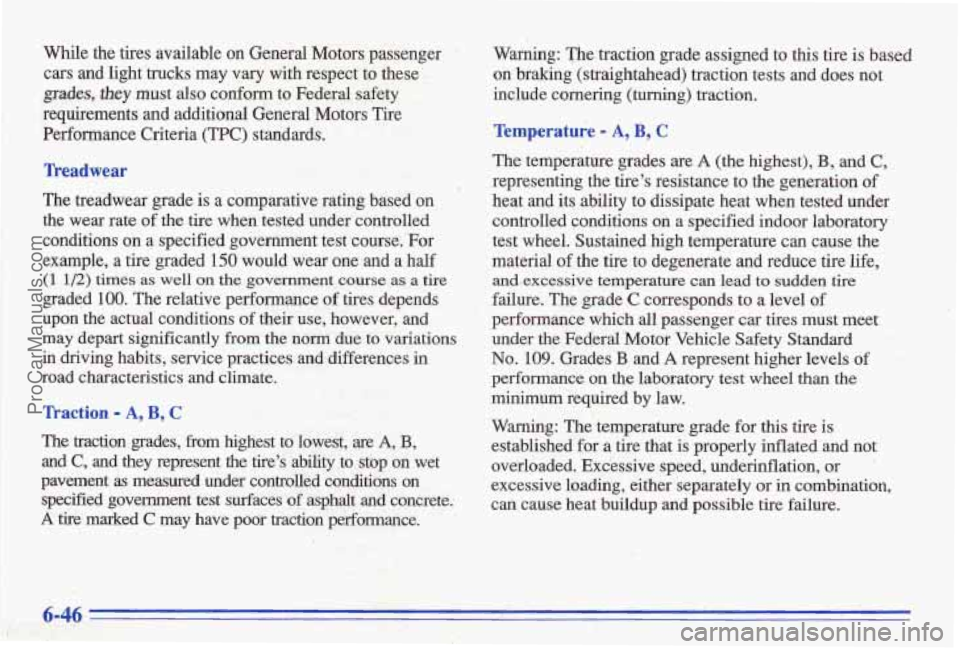
While the tires available on General Motors passenger .
cars and light 'trucks may vary with respect to these
grades, they must also conform to Federal safety
requirements and additional General Motors Tire
Perforrnance Criteria (TPC) standards.
Treadwear
The treadwear grade is a comparative rating based on
the wear rate of the tire when tested under controlled
conditions on a specified government test course. -For
example, a tire graded
150 would wear one and a half
(1 1/2) times as well on the government course as a tire
graded 100. The relative performance
of tires depends
upon the actual conditions
of their use, however, and
may
depart significantly from the norm due to variations
in driving habits, service practices and differences
in
road characteristics and climate.
Traction - A, B, C
The traction grades, from highest to lowest, are A, B,
and C, and they represent the tire's ability to stop on wet
pavement
as measured under controlid conditions on
..? specified government test surfaces of asphalt and concrete.
- A tire'marked C may have poor traction performance.
I
.~. .-I -
. I. . I .,. .. - -. ,. . . .. , .. 1. . , ;::-;.,;:,> ::; ,? ..';;Y, i ... . . ~ ~.:.:..-*,,~'.v ;,, - .%$ -,r- '.: '. . , -.; =,,,-, .-. *. :-,- =.: ; .,
Y1.Y. .r.
Warning: The traction grade assigned to this tire is based
on braking (straightahead) traction tests and does not
include cornering (turning) traction.
Temperature - A, B, C
The temperature grades are A (the highest), B, and C,
representing the tire's resistance to ,the generation of
heat and its ability to dissipate heat when tested under controlled conditions on
a specified indoor laboratory
test wheel. Sustained high temperature can cause the
material
of the tire to degenerate and reduce tire life,
andaxcessive temperature can lead to sudden tire
failure. The grade C corresponds to a level of
performance which all passenger car tires must meet
under the Federal Motor Vehicle Safety Standard
No. 109. Grades B and A represent higher levels of
performance on the laboratory test wheel than the
minimum required by law.
Warning: The temperature grade for this tire
is
established €or a tire that is properly inflated and not
overloaded. Excessive speed, underinflation, or
. '
excessive loading, either separately or in combination,
can cause heat buildup and possible tire failure.
6-46
ProCarManuals.com
Page 292 of 387
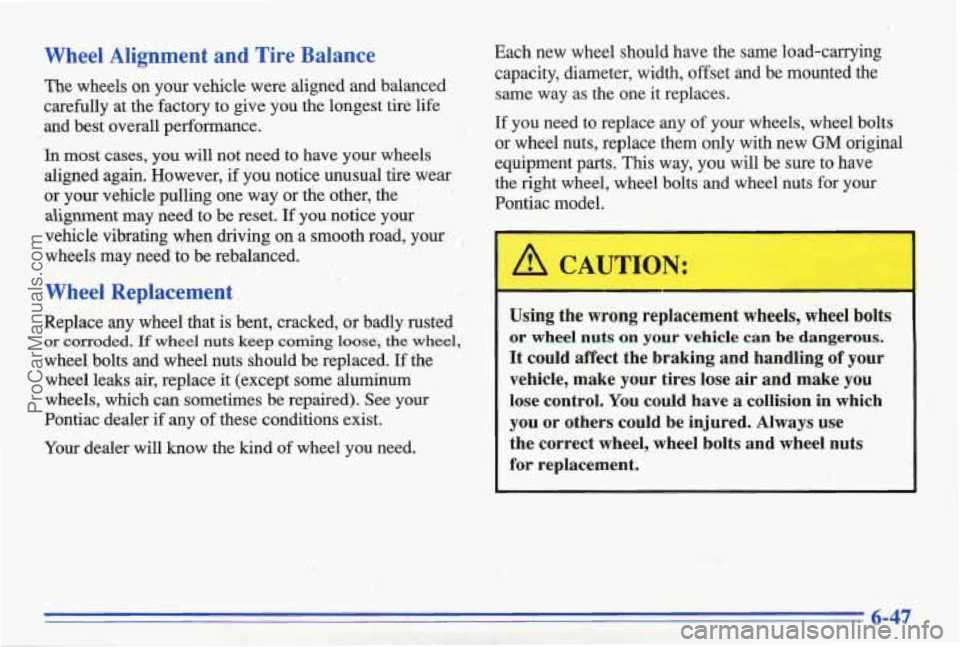
Wheel Alignment and Tire Balance
The wheels on your vehicle were aligned and balanced
carefully at the factory to give you the longest tire life
and best overall performance.
In most cases, you will not need to have your wheels
aligned again. However,
if you notice unusual tire wear
or
your vehicle pulling one way or tlie other, the
ahgnment may need to be reset. If you notice your'
vehicle vibrating when driving on a smooth road, your wheels may need' to be rebalanced.
, ,
Wheel Replacement
Replace any wheel that.is bent, cracked, or badly rusted
or corroded. If wheel nuts keep coming loose, the wheel,
wheel bolts and wheel nuts should be replaced. If the
wheel leaks air, replace it (except some alumhum
wheels, which can sometimes be repaired). See
your
Pontiac dealer if any of these conditions exist.
Your dealer will know the kind of wheel you need.
.- 1' . . , . .. ;
Each new wheel should have the same load-carrying
capacity, diameter, width, offset and be mounted the same way as the one it replaces.
If you need to replace any of your wheels, wheel bolts
or wheel nuts, replace them
only with new GM origipal
equipment parts.
This way, you will be sure to have
the right wheel, wheel bolts and wheel 'nuts for your
Pontiac model.
I
12 CAUTION:
Using the wrong replacement wheels, wheel bolts
or wheel
nuts on your vehicle can be dangerous.
It could affect the braking and handling of your
vehicle, make your tires lose air and make
you
lose control. You could have a collision in which
you or others could be injured. Always use
the correct wheel, wheel bolts and wheel nuts
for replacement.
6-47
ProCarManuals.com
Page 293 of 387
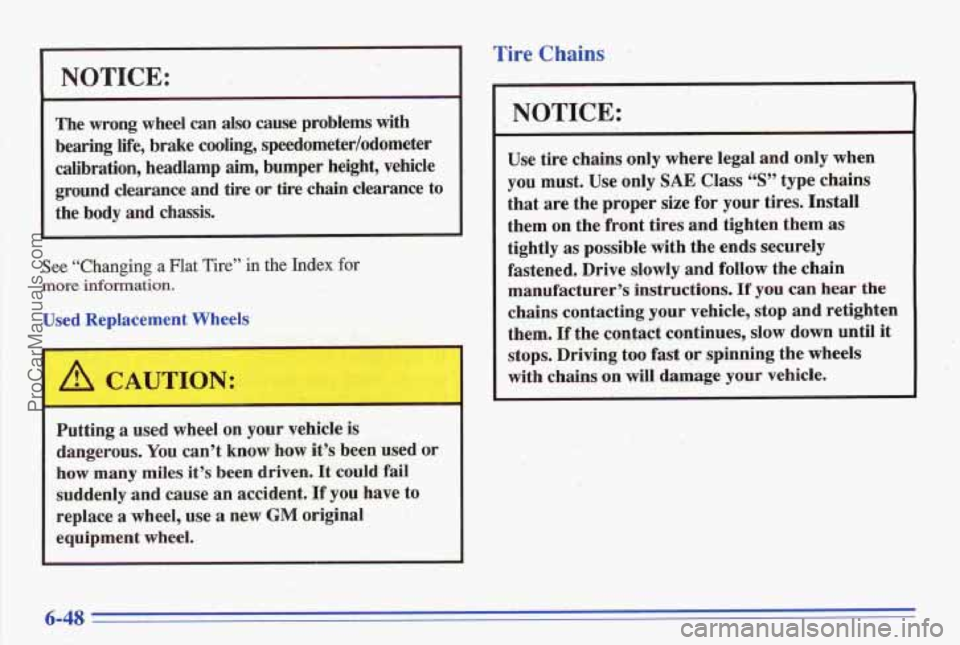
NOTICE:
The wrong wheel can also cause problems with
bearing life, brake cooling, speedometer/odometer
calibration, headlamp aim, bumper height, vehicle
ground clearance and tire or tire chain clearance to
the body and chassis.
.. -* ‘ .. ’ see “Changing a Flat Tire” in the Index for
‘more information.
.. .‘I, . .I .
.‘. -- . 8; . Putting a used wheel on your vehicle is
;. .. . dangerous. You can’t know how it’s been used or
,.; how many miles it’s been driven. It could fail
-. :% suddenly and cause an accident. If you have to
. -1 . .. I -.~ I., .<.
.. ?1 :: :. <.. >. - ., 3
I .) .
,,.. ‘,,‘t, . .?. I
.: replace a wheel, use a new GM original
.I , . ..
., , equipment wheel. -.
-. ., ..
I
Tire Chains
NOTICE:
Use tire chains only where legal and only when
you must. Use only
SAE Class 44S” type chains
that are the proper size for
your tires. Install
them on the front tires and tighten them as
tightly as possible with the ends securely
fastened. Drive slowly and follow the chain
manufacturer’s instructions.
If you can hear the
chains contacting
your vehicle, stop and retighten
them.
If the contact continues, slow down until it
stops. Driving too fast or spinning the wheels
with chains on will damage your vehicle.
* “
ProCarManuals.com
Page 294 of 387
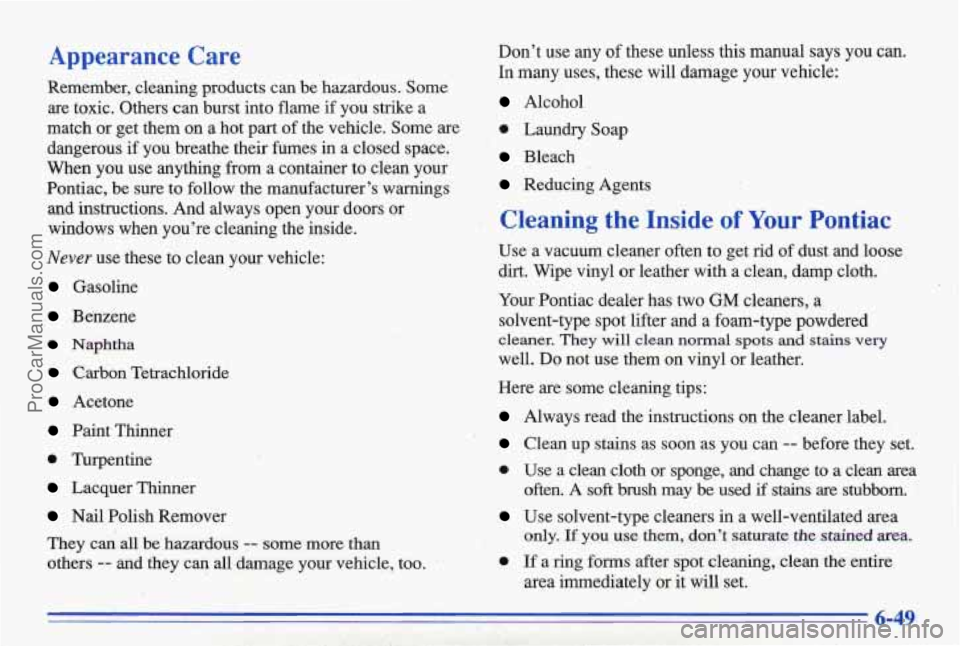
Appearance Care Don't use any of these unless this manual says you can.
In many uses, these will damage your vehicle:
Remember, cleaning products can be hazardous. Some
are toxic. Others can burst into flame
if you strike a Alcohol
match
or get them on a hot part of the vehicle. Some are 0 Laundry Soap
dangerous
if you breathe their fumes in a closed space.
When you use anything from a container
to clean your
Pontiac, be sure to follow the manufacturer's warnings
Reducing Agents
Bleach
and instructions. And always open your doors or
windows when you're cleaning the inside.
~: y -.% :'; - : Cleaning the Inside of Your Pontiac
Never use these to clean your vehicle:
Gasoline
Benzene
Naphtha
Carbon Tetrachloride
Acetone
PaintThinner
0 Turpentine
Lacquer Thinner
Nail Polish Remover
They can all be hazardous
T- some more than
others
-- and they can all damage your vehicle, too.
1.. . >, .. . ~.. ..&. - . .: .. .'#'.-: Use a vacuum cleaner often to get rid of dust and loose .f, r :'.;.,.,-
.I .. .., , ..; .. \..: ,.. i$,;--;;l .*. dirt. Wipe vinyl or leather with a clean, damp cloth ..
Your Pontiac dealer has two GM cleaners, a
solvent-type spot lifter and a foam-type powdered
cleaner. They will clean normal spots and stains very
well. Do not use them on vinyl or leather.
Here are some cleaning tips:
Always read the instructions on the cleaner label.
' Clean up stains as soon as you can -- before they set.
0 Use a clean cloth or sponge, and change to a clean area
Use solvent-type cleaners in a well-ventilated area
0 If a ring forms after spbt cleaning, clean the entire
often..
A
soft brush may be used if stains are stubborn.
only.
If you use them, don't saturate the stained ma.
ProCarManuals.com
Page 295 of 387

Using Foam-Type Cleaner on Fabric
Vacuum and brush the area to remove any loose dirt.
Always clean a whole trim phel or section. Mask
surrounding
trim along stitch or welt lines.
Mix’Multi-Purpose Powdered Cleaner following the
directions
on the container label.
Use suds only and apply with a clean sponge.
Don’t saturate the material.
Don’t
rub it roughly.
As soon as you’ve cleaned the section, use a sponge
to remove the
suds.
Rinse the section with a clean, wet sponge.
Wipe
off what’s left with .a slightly damp paper towel
or cloth.
Then
dry it immediately with a blow dryer.
Wipe with a clean cloth.
I
Using ,Solvent-Type Cleaner on Fabric
First, see if you have to use solvent-type cleaner at all,
Some spots and stains will clean off better with just
water
and mild soap.
If you need to use a solvent:
Gently scrape excess soil from the trim material with a
clean, dull knife or scrapex Use very little cleaner, light
pressure and clean cloths (preferably cheesecloth).
Cleaning should
start at the outside of ‘the stain,
“feathering” toward the center. Keep changing to
a clean section of the cloth.
area with
a blow dryer to help ‘prevent a cleaning ring.
0 When you clean a stain from fabric, immediately dry the
Special Cleaning Problems
Greasy or Oily - Stains
Stains caused by grease, oil, butter, margarine, shoe
polish, coffee with cream, chewing gum, cosmetic
creams, vegetable oils,
wax ,crayon, tar and asphalt can
be removed as follows:
0 Carefully scrape off excess stain.
Follow the solvent-type instructions descriw earlier.
ShOe.-pohh, wax crayon, tar and asphalt will stain if
left on a-vehicle’s seat fabric. They should be removed
as soon as possible. Be carefbl, because the cleaner
will dissolve them and
may cause them to spread.
ProCarManuals.com
Page 296 of 387
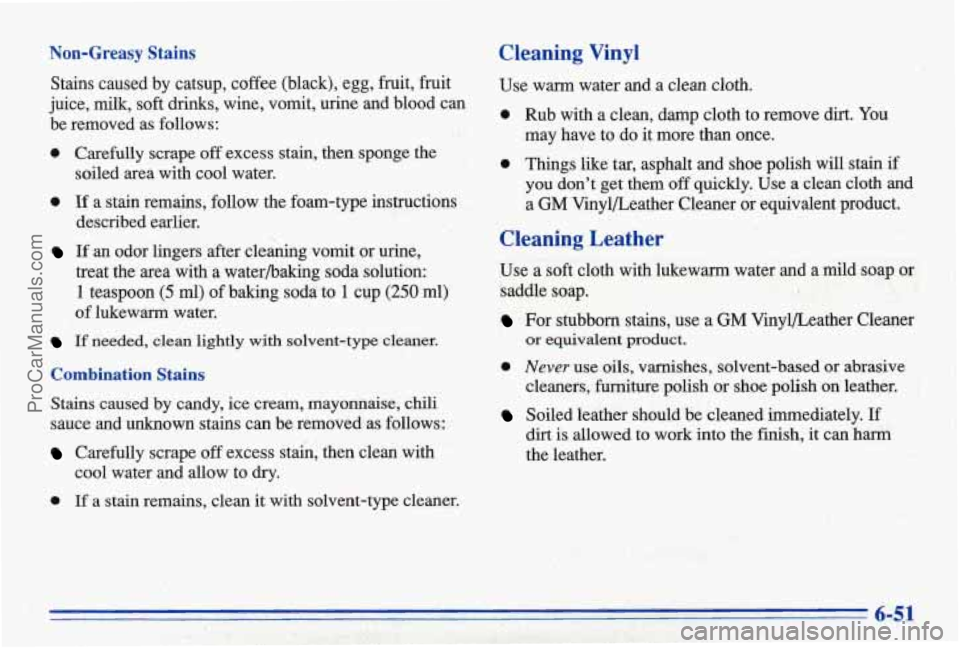
Non-Greasy Stains Cleaning Vinyl
Stains caused by catsup, coffee (black), egg, fruit, fruit
juice, milk, soft
drinks, wine, vomit, urine and blood can
be removed as follows:
0 Carefully scrape off excess stain, then sponge the
soiled area with cool water.
0 If a stain remains, follow the foam-type instructions
described earlier.
If an odor lingers after cleaning vomit or urine,
treat the
area with a waterbaking soda solution:
1 teaspoon (5 ml) of baking soda to 1 cup (250 ml)
of lukewarm water.
If needed, deanlightly with solvent-type cleaner.
Combination Stains
Stains caused by candy, ice cream, mayonnaise, chili
sauce and unknowri stains can be removed as follows:
Carefully scrape off excess st&, then clean with
cool 'water and allow
to dry. Use warm water and a clean cloth.
0 Rub with a clean, damp cloth to remove dirt. You
may have to do it more than once.
0 Things like tar, asphalt and shoe polish will stain if
you don't get them off quickly. Use a clean cloth and
a GM Vinylbeather
Cleaner or equivalent product.
Cleaning Leather
Use a soft cloth with lukewarm water and a mild soap or
saddle soap.
For stubborn stains, use a GM VinylLeather Cleaner
or equivalent product.
0 Never use oils, varnishes, solvent-based or abrasive
Soiled leather should be cleaned immediately. If
cleaners, furniture polish or shoe polish on leather.
dirt is allowed to work into the finish, it can harm
the leather.
0 If a stain remains, clean it with solvent-type cleaner.
6-51
ProCarManuals.com
Page 297 of 387
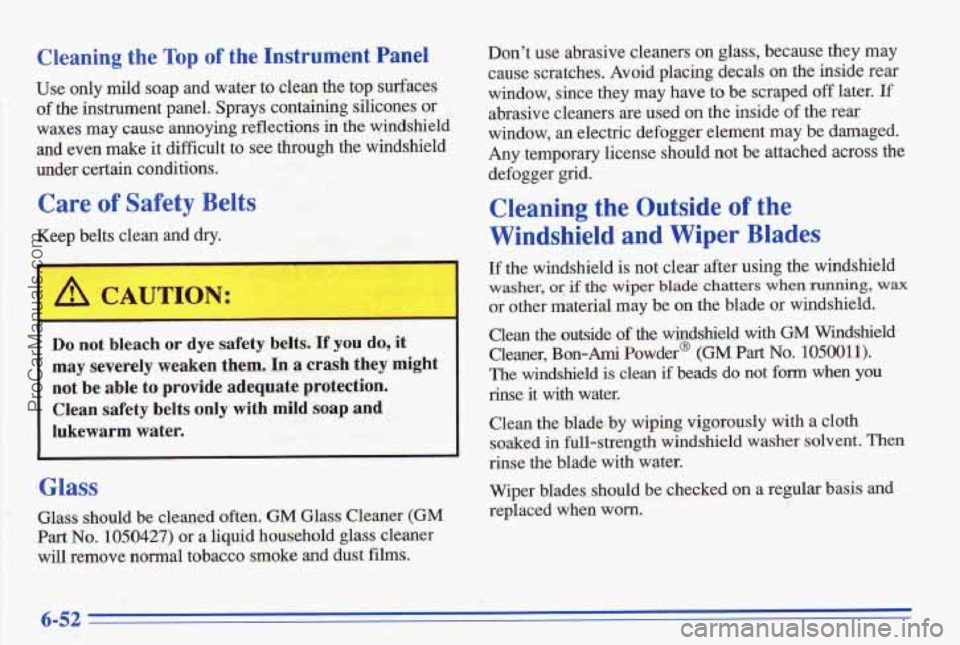
Cleaning the Top of the Instrument Panel
Use only mild soap and water to clean the top surfaces
of the instrument panel. Sprays containing silicones or
waxes may cause annoying reflections
in the windshield
and even make it difficult to see through the windshield
under certain conditions.
Care of Safety Belts
Keep belts clean and dry.
---
I A CAUF 'N:
r
-
Do not bleach or dye safety belts. If you do, it
may severely weaken them. In a crash they might
not be able to provide adequate protection.
Clean safety belts
only with mild soap and
lukewarm water.
Glass
Glass should be cleaned often. GM Glass Cleaner (GM
Part No. 1050427) or a liquid household glass cleaner
will remove norha1 tobacco smoke and dust films.
Don't use abrasive cleaners on glass, because they may
cause scratches. Avoid placing decals
on the inside rear
window, since they may have to be scraped
off later. Ilf
abrasive cleaners are used on the inside of the rear
window, an electric defogger element may be damaged.
Any temporary license should not be attached across the
defogger grid.
Cleaning the Outside of the
Windshield' and Wiper Blades
Lf the windshield is not clear after using the windshield
washer, or if the wiper blade chatters when Npning, wax
or other material m'ay be on the blade or windshield.
Clean the outside
of the wirmdshield with GM Windshield
Cleaner, Bon-Ami Powder@
(GM Part No. lQS0011).
The windshield is clean if beads do not form when you
rinse it with water.
Clean the blade by wiping vigorously with a cloth
soaked
in full-strength windshield washer solvent. Then
rinse the
blade with water.
Wiper blades should be checked
on a regular basis and
replaced when
worn.
6-52
.
ProCarManuals.com
Page 298 of 387
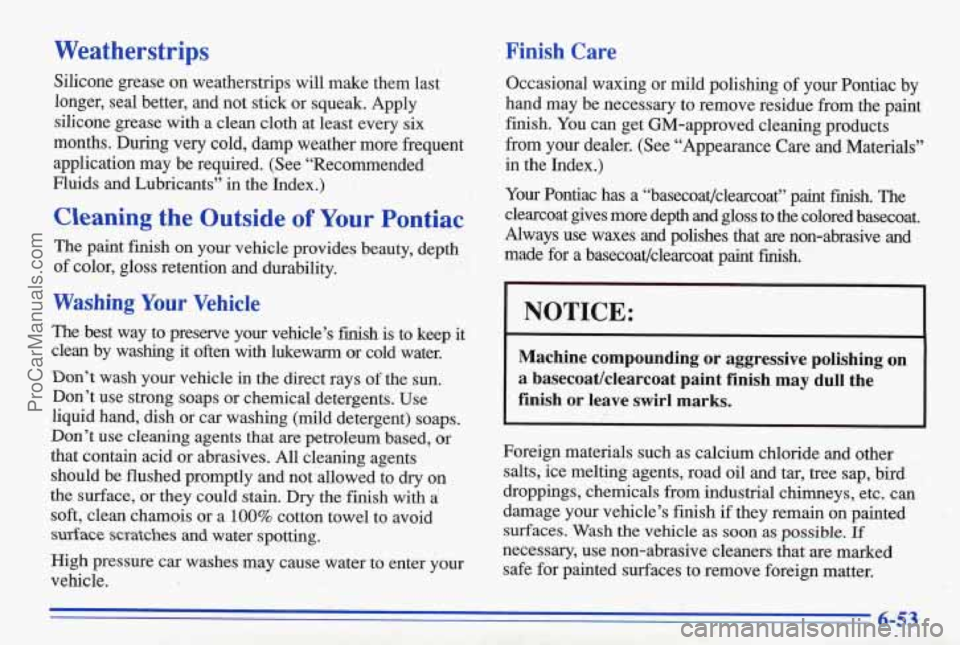
Weatherstrips
Silicone grease on weatherstrips will make them last
longer, seal better, and not stick or squeak. Apply
silicone grease with a clean cloth at least every six
months. During very cold, damp weather more frequent
application may be required. (See “Recommended
Fluids and Lubricants”
in the Index.)
Cleaning the Outside of Your Pontiac
The paint finish on your vehicle provides beauty, depth
of color, gloss retention and durability.
Washing Your Vehicle
The best way to preserve your vehicle’s finish is to keep it
clean by washing it often with lukewarm or cold water.
Don’t wash your vehicle in the direct rays of the sun.
Don’t use strong soaps or chemical detergents.
Use
liquid hand, dish or car washing (mild detergent) soaps.
Don’t use cleaning agents that are petroleum based, or
that contain acid or abrasives.
All cleaning agents
should be flushed promptly and not allowed to dry
on
the surface, or they could stain. Dry the finish with a
soft, clean chamois or a 100% cotton towel to avoid
suyface scratches and water spotting.
High pressure car washes may cause water to enter your
vehicle.
Finish Care
Occasional waxing or mild polishing of your Pontiac by
hand may be necessary to remove residue from the paint
finish. You can get GM-approved cleaning products
from your dealer. (See “Appearance
Care and Materials”
in the Index.)
Your Pontiac has a “basecoat/clearcoat” paint f~sh: The
clearcoat gives more depth
d gloss to the colored basecoat.
Always use waxes and polishes that are non-abrasive and
made for a basecoat/clearcoat paint
finish.
NOTICE:
Machine compounding or aggressive polishing on
a basecoatklearcoat paint finish may dull the
finish
or leave swirl marks.
Foreign materials such as calcium chloride and other salts; ice melting agents, road
oil and tar, tree sap, bird
droppings, chemicals
from industrial chimneys, etc. can
damage your vehicle’s finish
if they remain on painted
surfaces. Wash the vehicle as soon as possible,
If
necessary, use non-abrasive cleaners that are marked
safe for painted surfaces to remove foreign matter.
6-53
ProCarManuals.com
Page 299 of 387
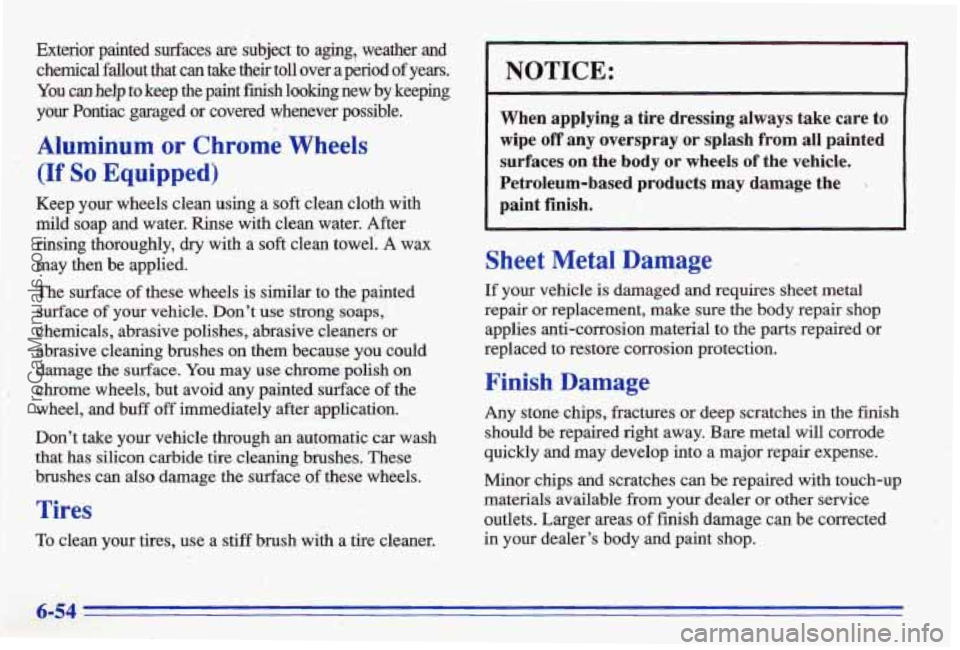
Exterior painted surfaces are subject to aging, weather and chemical fallout that can take their toll over a
pkriod of years.
You canhelp to keep the paint finish looking new by keeping
your Pontiac garaged or covered whenever possible.
Aluminum or Chrome Wheels
(If So Equipped)
Keep your wheels clean using a &oft clean cloth with
mild soap
and water. Rinse with clean water. After
rinsing thoroughly,
dry with a soft clean towel'. A wax
may then be applied.
The surface of'these wheels is similar to the painted
surface
of your vehicle. Don't use strong soaps,
chemicals, abrasive polishes, abrasive cleaners or
abrasive cleaning brushes
on them because you could
damage
the surface. You may use chrome polish on
chrome wheels, but avoid any painted surface of the
wheel,
and buff off immediately after application.
Don't take your vehicle through
an automatic car wash
that
has silicon carbide tire cleaning brushes. These
brushes can
also damage the surface of these wheels.
Tires
To clean your tires, use a stiff brush with a tire cleaner.
NOTICE:
When applying a tire dressing always take care to
wipe
off any overspray or splash from all painted
surfaces
on the body or wheels of the vehicle.
Petroleum-based products may damage the .l
paint finish.
Sheet Metal Damage
If your vehicle is damaged and requires sheet metal
repa3 or replacement, make sure the body repair shop
applies anti-corrosion material
to the parts repaired or
replaced to' restore corrosion protection.
Finish Damage
Any stone chips, fractures or deep scratches in the finish
should be repaired right away. Bare metal will corrode
quickly and may develop into a major repair expense.
Minor chips and scratches can
be repaired with touch-up
materials available from
your dealer or other service
outlets. Larger areas
of finish damage can be corrected
in your dealer's body and paint shop.
*.,,,: ; ,?'... '. - ' ,ti .. .. ..
ProCarManuals.com
Page 300 of 387
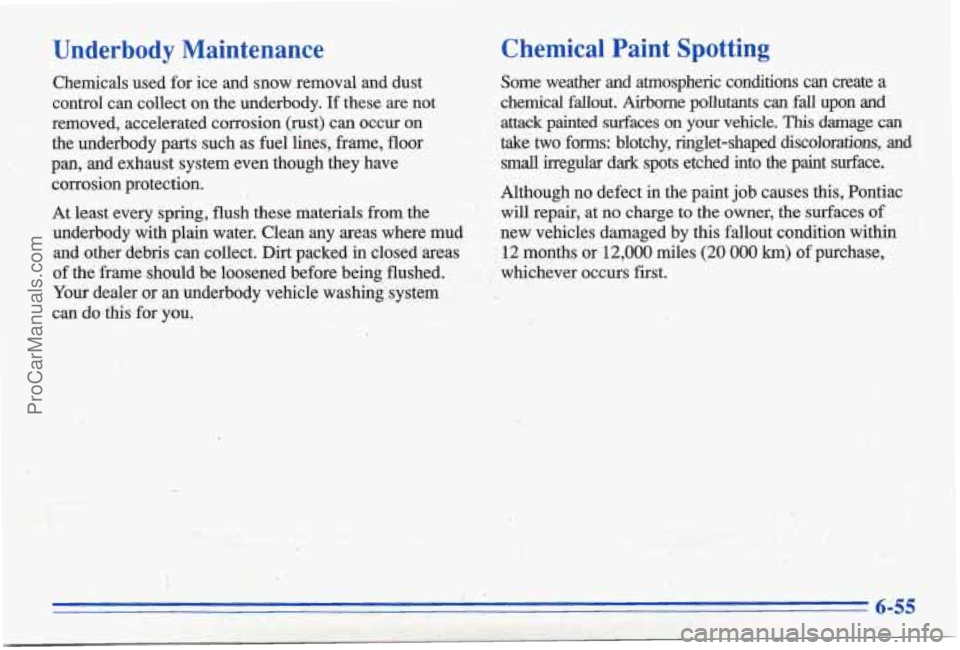
Underbody Maintenance
Chemicals used for ice and snow removal and dust
control
can collect on the underbody. If these are not
removed, accelerated corrosion (rust) can occur on
the underbody parts such as fuel lines, frame,
floor
pan, and exhaust system even though they have
corrosion protection.
At least every spring, flush these materials from the
underbody with plain water. Clean any areas where mud and other debris can collect.
Dirt packed in closed areas
of the frame should be loosened before being flushed.
Your dealer or
an underbody vehicle washing system
can
do this for you.
Chemical Paint Spotting
Some weather and atmospheric conditions can create a
chemical fallout. Airborne pollutants can fall upon and
attack painted surfaces on your vehicle. This damage can .
take two forms: blotchy, ringlet-shaped discolorations, and
small irregular dark spots etched into the paint surface.
Although no defect in the paint
job causes this, Pontiac
will repair, at no charge
to the owner, the surfaces of
new vehicles damaged by this fallout condition within
12 months or 12,000 miles (20 000 km) of purchase,
whichever occurs
first.
ProCarManuals.com